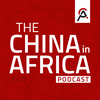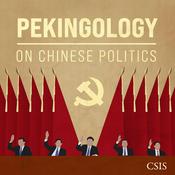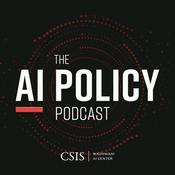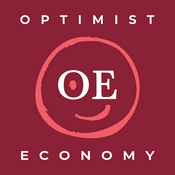336 episodes

China's Outsized Role in West Africa's Illegal Resource Trade
2025/12/18 | 52 mins.
Every year, illegal mining, fishing, and logging drain billions of dollars from West Africa's economies as the problem persists largely unchecked, with Chinese actors playing an outsized role. Fueled by chronic corruption among local regulators across the region and seemingly insatiable demand for these resources in China, curtailing these illegal activities often feels impossible. But there's still hope. Earlier this year, a group of 21 scholars and analysts, mostly from West Africa, came together to develop new solutions and policy recommendations to reform the mining, timber, and fishing trades, empowering local communities while reducing local corruption. Their findings were released earlier this fall in a series of three reports co-published by the Keogh School of Global Affairs at the University of Notre Dame and the Atlantic Council in Washington, D.C. Two of the project organizations, Notre Dame Professor Joshua Eisenman, and Caroline Costello, assistant director of the Atlantic Council's Global China Hub, join Eric & Géraud to discuss the reports and how China can play a constructive role in helping to end illegal resource extraction in West Africa. 📌 Topics covered include: China's environmental footprint in West Africa Why illegal extraction persists despite strong laws The politics behind "China-free" resource corridors Lessons from China's ivory ban and whether rosewood could be next What African governments — not just China — must do differently Download the reports: Chinese mining in West Africa: Responding to the environmental and social impacts Chinese fishing in West Africa: Responding to the environmental and social impacts Chinese demand for timber and wildlife in West Africa: Responding to the environmental and social impacts Show Notes: The Financial Times: The American company seeking to counter China in Africa by David Pilling and Leslie Hook Foreign Policy: China's Appetite for Rosewood Is Causing Chaos in Africa by Joshua Eisenman and Caroline Costello Environmental Investigation Agency: New Report Finds That Home Depot Sold Illegally Sourced Tropical Wood for Years Join the Discussion: X: @ChinaGSProject | @eric_olander | @stadenesque | @christiangeraud Facebook: www.facebook.com/ChinaAfricaProject YouTube: www.youtube.com/@ChinaGlobalSouth Now on Bluesky! Follow CGSP at @chinagsproject.bsky.social Follow CGSP in French and Spanish: French: www.projetafriquechine.com | @AfrikChine Spanish: www.chinalasamericas.com | @ChinaAmericas Join us Patreon! Become a CGSP Patreon member and get all sorts of cool stuff, including our Week in Review report, an invitation to join monthly Zoom calls with Eric & Cobus, and even an awesome new CGSP Podcast mug! www.patreon.com/chinaglobalsouth

China's Role in Africa's Industrialization: Obstacle, Partner, or Both?
2025/12/12 | 1h 5 mins.
Africa's industrialization push is colliding with the defining economic question of this era: how can any country or region climb the manufacturing value chain so long as China dominates industrial production of pretty much, well, everything? But even if overcoming the China question is possible, African leaders then face a second, more daunting obstacle: infrastructure. The lack of reliable power, water, roads, and other infrastructure necessary to support industrialization is severe in many parts of the continent. A new book by Professor Carlos Oya, a preeminent China-Africa scholar at the University of London, details China's complex role in Africa's pursuit of industrialization. Eric & Cobus speak with Carlos about how China is simultaneously a big challenge and an important part of the solution. Topics covered Why industrialization is back at the center of African economic strategy The infrastructure constraint: electricity costs, reliability, and targeted hubs Ethiopia's experience: what worked, what didn't, and why it mattered China's evolving role: from policy-bank infrastructure to private manufacturing plays The evidence on "Chinese labor" myths and what research actually shows Download the book (free): Cambridge University Press: China for Africa's Industrialization? by Carlos Oya Join the Discussion: X: @ChinaGSProject | @eric_olander | @stadenesque | @christiangeraud Facebook: www.facebook.com/ChinaAfricaProject YouTube: www.youtube.com/@ChinaGlobalSouth Now on Bluesky! Follow CGSP at @chinagsproject.bsky.social Follow CGSP in French and Spanish: French: www.projetafriquechine.com | @AfrikChine Spanish: www.chinalasamericas.com | @ChinaAmericas Join us Patreon! Become a CGSP Patreon member and get all sorts of cool stuff, including our Week in Review report, an invitation to join monthly Zoom calls with Eric & Cobus, and even an awesome new CGSP Podcast mug! www.patreon.com/chinaglobalsouth

Why the U.S.-DRC Mining Deal is Bad News For China
2025/12/06 | 58 mins.
The U.S. and the DR Congo signed a landmark deal on critical minerals during President Félix Tshisekedi's visit to the White House this week. The pact provides the U.S. with extraordinary access to the Congolese mining sector and is widely expected to inhibit Chinese mining companies in the DRC from expanding their operations. CGSP Africa Editor Géraud Neema joins Eric & Cobus to break down the details of the deal and explain why what happened in the DRC could set a dangerous precedent for Chinese mining operations in other African countries. JOIN THE DISCUSSION: X: @ChinaGSProject | @eric_olander | @stadenesque | @christiangeraud Facebook: www.facebook.com/ChinaAfricaProject YouTube: www.youtube.com/@ChinaGlobalSouth Now on Bluesky! Follow CGSP at @chinagsproject.bsky.social FOLLOW CGSP IN FRENCH & SPANISH: French: www.projetafriquechine.com | @AfrikChine Spanish: www.chinalasamericas.com | @ChinaAmericas JOIN US ON PATREON! Become a CGSP Patreon member and get all sorts of cool stuff, including our Week in Review report, an invitation to join monthly Zoom calls with Eric & Cobus, and even an awesome new CGSP Podcast mug! www.patreon.com/chinaglobalsouth

China at COP30 and the New Politics of Climate Change
2025/11/27 | 48 mins.
With the U.S. absent from two major international summits this month, the G20 in South Africa and the COP30 in Brazil, we got an early look at what the post-American order is starting to look like. In both instances, China moved to fill the void left by the U.S., taking on a much more prominent role. Anika Patel, China analyst at the non-profit climate news site Carbon Brief, reported extensively from COP30 and noted a key difference in Beijing's messaging at the different summits in Johannesburg and Belém. In South Africa, Chinese Premier Li Qiang sought to position Beijing as an emergent global norm-setter, whereas in Brazil, the Chinese delegation explicitly rejected a leadership role. Anika joins Eric & Cobus to discuss China's complicated position at the COP30 summit and why, even though it's the world's leader in climate energy and technology, the country explicitly doesn't want the designation "climate leader." 📌 Key topics in this episode: • China's unusually prominent role at COP30 as the U.S. stayed away • Why China rejects the "climate leader" label despite its influence • How consensus politics shaped COP30 outcomes on finance, fossil fuels, and just transition • Climate finance tensions and China's insistence on developing-country status • Battles over CBAM, EV tariffs, rare earths, and other unilateral trade measures • How developing countries weigh cheap Chinese green tech against local industry goals • Why China's carbon market, energy transition, and pavilion drew huge interest at COP30 SHOW NOTES: Carbon Brief: COP30: Key outcomes for food, forests, land and nature at the UN climate talks in Belém Carbon Brief: COP30: Key outcomes agreed at the UN climate talks in Belém JOIN THE DISCUSSION: X: @ChinaGSProject | @eric_olander | @stadenesque Facebook: www.facebook.com/ChinaAfricaProject YouTube: www.youtube.com/@ChinaGlobalSouth Now on Bluesky! Follow CGSP at @chinagsproject.bsky.social FOLLOW CGSP IN FRENCH & SPANISH: French: www.projetafriquechine.com | @AfrikChine Spanish: www.chinalasamericas.com | @ChinaAmericas JOIN US ON PATREON! Become a CGSP Patreon member and get all sorts of cool stuff, including our Week in Review report, an invitation to join monthly Zoom calls with Eric & Cobus, and even an awesome new CGSP Podcast mug! www.patreon.com/chinaglobalsouth

How China Uses Parliamentary Buildings to Build Influence in Africa
2025/11/25 | 41 mins.
China has funded, designed, and built more than 200 government buildings across Africa, including the headquarters of the African Union and Ecowas, foreign ministry annexes in Ghana and Kenya, and at least 15 national parliaments. Eric and Cobus speak with Innocent Batsani-Ncube, an associate professor of African politics at Queen Mary University of London and author of the new book China and African Parliaments. Drawing on extensive fieldwork in Lesotho, Malawi, and Zimbabwe, Batsani-Ncube explains how China's parliamentary construction boom works, why African governments welcome it, and what he calls "subtle power"—a form of elite-level influence that sits between soft and sharp power. 📌 Key topics in this episode: Why China builds African parliamentary buildings — and why African governments accept them "Subtle power" vs. soft power vs. sharp power The politics behind construction, design, and land selection How these buildings shape legislative capacity and political identity Case studies: Lesotho, Malawi, Zimbabwe, Congo-Brazzaville Does this compromise sovereignty? Or strengthen parliaments? Are these buildings really vectors for Chinese espionage? 📘 Purchase China and African Parliaments by Innocent Batsani-Ncube on Amazon JOIN THE DISCUSSION: X: @ChinaGSProject | @eric_olander Facebook: www.facebook.com/ChinaAfricaProject YouTube: www.youtube.com/@ChinaGlobalSouth Now on Bluesky! Follow CGSP at @chinagsproject.bsky.social FOLLOW CGSP IN FRENCH & SPANISH: French: www.projetafriquechine.com | @AfrikChine Spanish: www.chinalasamericas.com | @ChinaAmericas JOIN US ON PATREON! Become a CGSP Patreon member and get all sorts of cool stuff, including our Week in Review report, an invitation to join monthly Zoom calls with Eric & Cobus, and even an awesome new CGSP Podcast mug! www.patreon.com/chinaglobalsouth
More Government podcasts
Trending Government podcasts
About The China in Africa Podcast
Listen to The China in Africa Podcast, Pekingology and many other podcasts from around the world with the radio.net app

Get the free radio.net app
- Stations and podcasts to bookmark
- Stream via Wi-Fi or Bluetooth
- Supports Carplay & Android Auto
- Many other app features
Get the free radio.net app
- Stations and podcasts to bookmark
- Stream via Wi-Fi or Bluetooth
- Supports Carplay & Android Auto
- Many other app features


The China in Africa Podcast
download the app,
start listening.

















